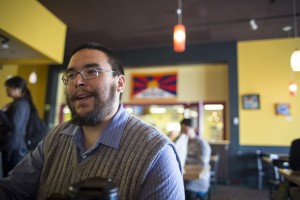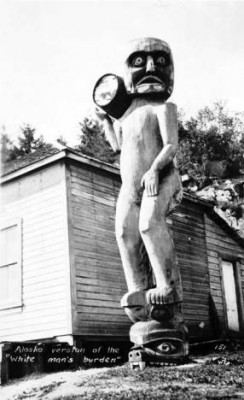Master's thesis examines the use and understanding of alcohol among Alaska Natives
by Jamie Gonzales |

There were several thesis topics that grabbed the interest of Tlingit scholar and master's candidate Kyle Wark, all were challenging and previously unstudied, but only one was truly personal. He opens his thesis abstract with this: "Alcohol killed my mom. Her life and death motivated me to learn how my Tlingit people got to this place we find ourselves in regarding alcohol."
He defended his thesis, "Yéil Kaawashòo, 'Raven was Drinking': An ethnotoxicology of alcohol among the Tlingit," to a standing-room-only crowd in the spring. In the audience were mentors, professors, friends and colleagues from ISER, and from First Alaskans Institute, where he now works, as well as Tlingit elders, including his own great-aunt.
"That made me incredibly nervous, but the responses were overwhelmingly positive for tackling the issue and for sharing my own personal story, which is a big part of my thesis," he said. (View a 90-minute segment of Wark's thesis defense.)
While public health investigators and behavioral health researchers have studied Alaska Natives and alcoholism, and some anthropologists have studied colonial alcohol use among Euro-Americans, Wark is the first anthropologist to approach the topic from the Native perspective.
"I was looking at cultural factors, how people react to drinking, why people drink and what alcohol means in a culture and why it's used in a culture," he said. "What does it mean to the Native people to consume alcohol?"
The myth of scientific objectivity
If you're like me, then at some point during your education, a teacher drilled into you the idea that science must be objective, that the researcher is a detached observer and recorder.
When I mentioned this in a conversation last spring with UAA Professor Emeritus Steve Langdon, a noted anthropologist and Wark's thesis committee chair and graduate adviser, it was met with vigorous head-shaking objection. Even the simple act of choosing what to study contains bias, he said. Anthropology has made room for the humanity of its practitioners.
"The culture of alcohol that I was raised in with my mom forms a central piece of my thesis, a narrative thread tying things together. It's part of a genre within anthropology called autoethnography," explained Wark. "It's a way of a researcher examining their own culture and cultural biases and experiences."
When Wark stumbled into anthropology almost a decade ago, he was surprised to realize that he'd been doing anthropology since he was a little kid. From looking at boxes of batteries and trying to sound out the foreign languages on the labels and think about what it meant for there to be different languages and different systems of writing — linguistic anthropology — to parsing the stories his grandpa told him and understanding that different cultures understood the world differently.
"I was really fascinated by this story my grandpa told me when I was about four. That the Tlingit believe that the Earth rested in the hand of an old woman and when she shook with a palsy we had earthquakes. But the Japanese, he said, thought the world rested on the back of a giant spider and when it crawled around its web we had an earthquake," he said.
Choosing to study anthropology at the graduate level was a way for Wark to better understand himself and the world around him. He'd studied Western classics as an undergrad, Eastern classics as a graduate student and had just begun to study anthropology when he realized, "I wasn't Eastern or Western, I was something else. I was Northern, with my Tlingit background."
Challenging prevailing ideas about alcohol use and abuse
Autoethnography was the framework Wark needed to tie together the many elements of his research, which included historical study, linguistics, public health data and even economics.
Ethnotoxicology, he explained, is an even more niche field of anthropology. Generally considered a subfield of ethnobotany (a culture's understanding and use of plants), it's more traditionally been used to study a culture's use of poisons — think poisoned arrows. There has been some study of intoxicants, but as far as Wark knows — and he's done some serious digging in the literature — he's the first to use it to study a culture's understanding and use of alcohol.
After tracing the history of alcohol use by Euro-Americans back thousands of years, and among the Tlingit people back hundreds of years and examining the culture surrounding alcohol in archival literature and in language (clues to historical attitudes about alcohol exist in the evolution of the words the Tlingit use to talk about it), Wark argues in his thesis for an illness model of addiction, grounded in culture, rather than what he terms the "biological reductionism" of the disease model of addiction.
He explained his thinking like this: "The AA model — 'once an alcoholic, always an alcoholic' — that amounts to biological reductionism, to the idea that biology is the only explanation. That social factors and cultural factors and socio-economic status and historic trauma, none of these things have any impact on why you drink or how you drink. It's just your biology, it's just your brain, they think. I disagree."

To illustrate the power of cultural influence on human behavior, Wark cited the indigenous Kwakwaka'wakw people of Vancouver Island.
"The literature suggests they believed that when you drink elderberry juice, just straight up elderberry juice, you get drunk. Other people tried to drink it and nothing happened to them," he said. "And they believed that when you eat gumboots — chiton, little black mollusks — and then smoke tobacco immediately after, you then lose control of your locomotor functions and you turn towards the water and walk like a robot, mechanically sleepwalking down to the water and unless somebody shakes you to wake you up, you'll walk into the sea and wake yourself up."
These seemingly real, physiological effects on the Kwakwaka'wakw people are culturally determined, Wark said, an observation elastic enough to explain some of the effects of alcohol on Alaska Native people, he thinks.
Wark doesn't deny the actual metabolic effects of alcohol on human physiology, including physical addiction, but he does argue that what even some Native elders accept as biological truth — "that we have an inherited or biological weakness as Native people to alcohol" — has no basis in fact, but it's been repeated enough that whole people groups have internalized that message.
"My mom probably internalized that message. But it's not true. It's been [proven to be] factually incorrect since at least the 1950s, but it still keeps getting repeated. It's based on 19th century racist ideologies," Wark said.
Linguistic clues
The opening title of Wark's thesis, "Yéil Kaawashòo," uses a Tlingit term for drunkenness, "kaawashòo" (Yéil = Raven), that is linguistically related to another Tlingit term, "ka-li-shoo," that means "to persecute or torment."
"In Tlingit culture, the only people who were physically tormented, beaten, were the naak'w s'aati, those who hurt other people through the use of spirits or negative spirituality, often called witchcraft," explained Wark. "So there seems to be this linguistic link between beating a witch and being drunk. Same linguistic root words. Being drunk is like being possessed by an evil spirit, or even being taken as a slave."
To lose your independence and fall under someone else's power are both viewed as shameful in Tlingit culture, he further explained.
There is the idea in Tlingit culture that, Wark continued, "You need to be hard, literally like a stone. If you're dense and heavy, hard and firm, then the naak'w s'aati influence will bounce off of you." If you fall under someone else's power-here again the link between witches and alcohol — you've failed.
"You weren't strong enough to resist," he said. An old Tlingit attitude toward drunkenness is there in the history of the language.
Sharing his story, continuing his research
Wark said most days he still doesn't quite feel "done" with his thesis. There's always one more article to read, one more archival document to look at, one more piece of the complicated puzzle to write about. With encouragement from his thesis committee, he plans to turn his thesis into a book. Autoethnography was the way for him to frame the research, and could tell the full story of alcohol that academic language couldn't. It just might be the framework that lets new generations of researchers understand a complex issue from a fresh, first-person perspective.
"Writing about 150 years of colonial history, spread across 40,000 square miles of territory, under two different Euro-American governmental regimes with all sorts of different competing factors... you lose sight of the human element," he said. "You lose sight of what it means to be a human in all that. So autoethnography gives the reader a handle. What does all this history mean to a human? What does it mean to grow up with an alcoholic mom?"
Wark is now the indigenous researcher and policy analyst for First Alaskans Institute in the Alaska Native Policy Center. He was also featured in Anchorage Daily News's "State of Intoxication" series, in an "Alcohol & Me" video by Marc Lester. You can hear his personal story here.
Written by Jamie Gonzales, UAA Office of University Advancement
 "Master's thesis examines the use and understanding of alcohol among Alaska Natives" is licensed under a Creative Commons Attribution-NonCommercial 4.0 International License.
"Master's thesis examines the use and understanding of alcohol among Alaska Natives" is licensed under a Creative Commons Attribution-NonCommercial 4.0 International License.














